|
"Take-home" vs. "Bulk"
1954 - During this year ice cream production reached
4 million gallons, or 15.36 pints per head of population, a 10% increase
on the previous year. 2.36 million gallons (58%) was sold as "bulk" ice
cream, ie., in large containers for scooping.
Bulk ice cream was filled into 1 gallon or 2 1/2 gallon cylindrical cans,
or larger, for distribution to dairies and milk bars, either scooped
into
cones
(a pint produced seven to eight four-penny ice cream cones), or served
in cups or on dishes.
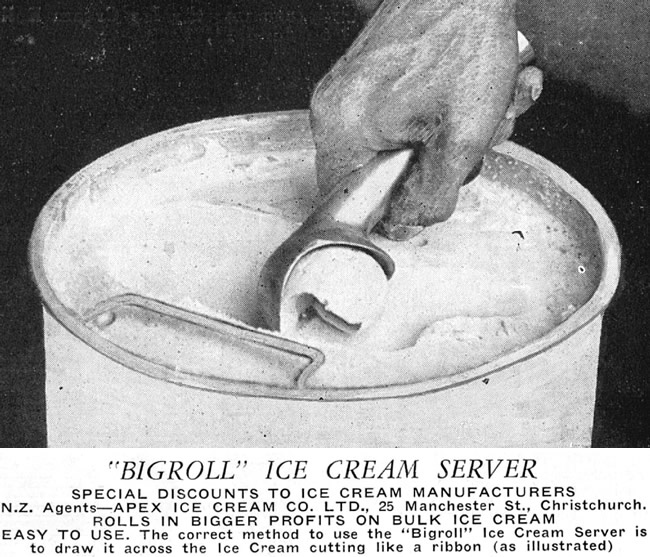
BIGROLL ice cream scoop advertisement, 1953.
- Frostee Digest.

NZICMA bulk (scoop) ice cream poster and guide to usage, early
1950s.
- Owen Norton collection.
However there was now one domestic refrigerator in every two homes in
New Zealandand the spread of refrigerators brought about a big change
in the proportion of ice cream sold as traditional "bulk" ice
cream, to more and more "take-home" ice
cream.
Take-home ice cream was packaged at the factory, most commonly in waxed
cardboard pint and quart packs, but also in half-pints, and "sixpenny
bricks", for home consumption.
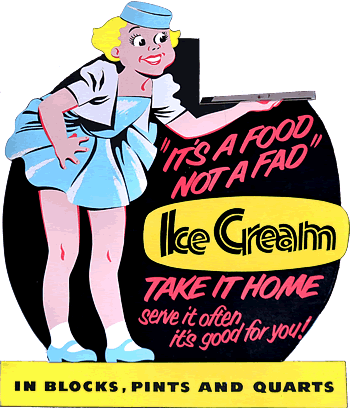
NZICMA take home ice cream stand-up display card, early
1950s.
- Owen Norton collection.

Wholesale and retail pricing for bulk, take-home
and novelties, by region, 1954.
- The Frostee Digest, NZICA archives.

Snowdrop Ice Cream Co., Ashburton, 1955, with proprietor Mr Ian
Paterson. Note NZICMA take-home display card in window.
- The Frostee Digest, NZICA archives.
The National Film Unit made a short feature film on ice cream manufacture
following an industry radio campaign based on the theme 'Take
Home Ice Cream - Take Home Health.'
Another successful radio advertising campaign which ran from 1957 to 1960 was
based on the slogan "Meal Time is Ice Cream Time".
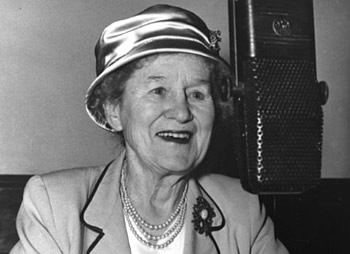
Leaflets were distributed widely to back up the radio adverts, which
were fronted by Aunt Daisy (above). The campaign
promoted ice cream at breakfast, lunch and dinner time.
May 1954 - the NZ Ice Cream Manufacturers'
Assn (NZICMA) ran their first Ice Cream Week,
a four-day training course for the ice cream industry
run by the Assn's Technical Adviser Mr Frank Morgan,
registration fee £1.
1954 -
The Food Hygiene Regulations were amended to allow
'composite shops', ie., those
selling vegetables and other un-packaged foods, to
also sell bulk ice cream, scooped on the premises.
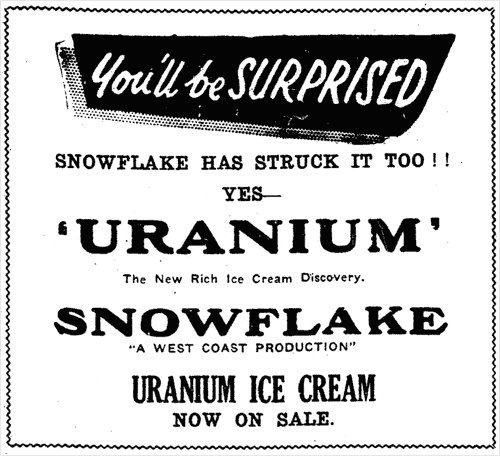
Snowflake Uranium Ice Cream advertisement,
Grey River Argus, 23 November 1955
- Te
Ara – The Encyclopedia of New Zealand.
1955 - another, potentially not-so-healthy ice cream
marketing exercise was run by Westland Snowflake Ice Cream
Ltd, when it advertised Uranium Ice Cream.
 Listen
to Owen Norton, former owner and
Director of Westland Snowflake, explain the background,
talking to Bryan Crump on Radio
NZ National programme - Kete West Coast. Listen
to Owen Norton, former owner and
Director of Westland Snowflake, explain the background,
talking to Bryan Crump on Radio
NZ National programme - Kete West Coast.
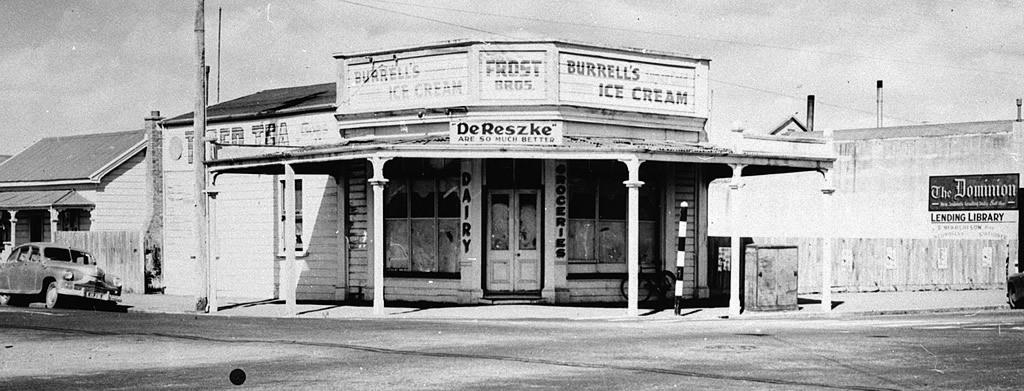
Burrell's Ice Cream advertised on Frost Bros.dairy and grocery,
on the corner of Rangitikei and Featherston Streets., Palmerston
North, 1955 (detail). Photo by Bruce Watt.
- Manawatu
Heritage.
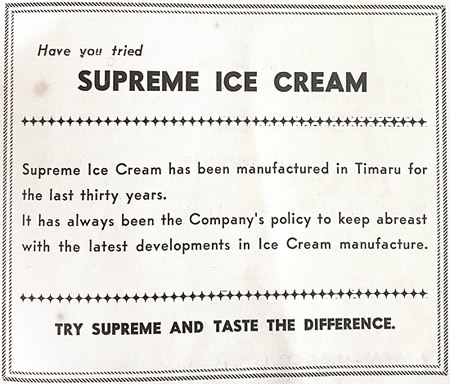
Supreme Ice Cream advertisement, 1950s, from a recipe book
published by the Wakari Branch of the Dunedin Free Kindergarten.
- Babette Kreyenhop.
In an unusual display of commercial openness, the Peerless
Ice Cream company of Wanganui included a copy of a typical
commercial ice cream recipe from the 1950's in one of their advertisements:
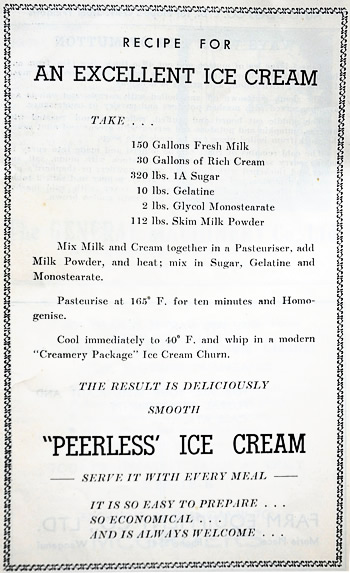
Peerless Ice Cream advertisement, 1950s.
Wanganui Free Kindergarten Assn.
Recipe Book, via Massey family.
Gelatine (made from beef skin) was one of the most
common commercial stabilisers used, with benefits of slowing ice
crystal growth during storage, and giving the ice cream a very smooth
texture, and clean flavour release.
Glycerol Monostearate (GMS), a derivative
of tallow, was the typical commercial emulsifier
used, helping the integration of milkfat and protein
during processing, and also contributing to a smoother,
better-keeping product.

Ice cream packaging, late 1950s, Sparrow Industrial Pictures Ltd.
Bulk can (scooping pack), top left.
Brands (clockwise from top): Rob Roy, Clarke's, Hostess, Bar-Lo-Bar (Barlows?),
New American, Aurora, Tui, Super Cold, Havmor, Tip Top.
- Auckland
Museum.
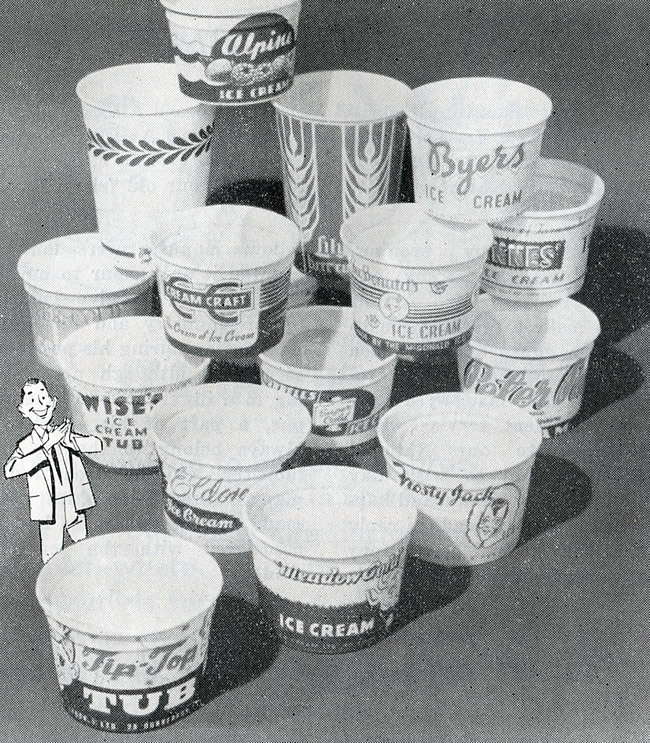
From an advertisement for "The new Lily Ice Cream Tub",
1958. Manufactured in N.Z. by
Carton Specialties, distributed
by Frank M. Winstone Ltd. Branded tubs include Alpine,
Byers,
Dennes', McDonald's, CreamCraft, Super Cold, Wise's, Burrells, Peter
Pan,
Eldora, Frosty Jack, Meadow Gold and Tip Top.
- Frostee Digest.
1954 - Coker & Mills Ice Cream was
established in a factory that was originally a malthouse for a brewery,
in Dodson St, Blenheim.
By 1955, the ice cream unit used for the NZ consumers
price index (CPI) basket of goods and services was changed to a pint
block (568mls), which was valued at 20 pence ($3.65 in today's terms).

The Blue Moon Dairy and ice cream garden, Hastings, late 1950s.
- Chris Beall - Hawke's
Bay Today.
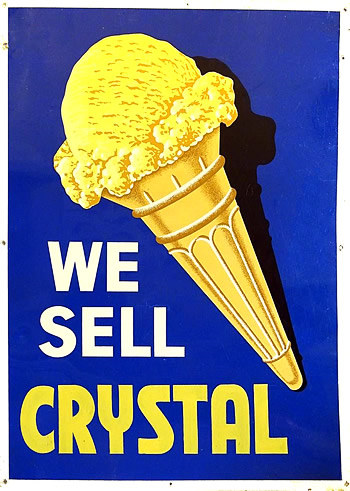
Crystal Ice Cream (Dunedin) sign.
- dt.
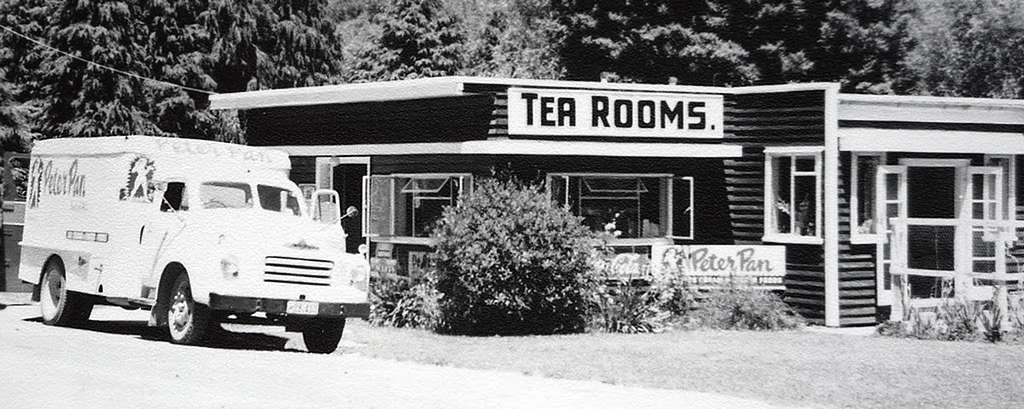
Peter Pan ice cream delivery, Morere Hot Springs Tearooms, around
1960.
- transpress
nz.
New Food Regulations
1959 - Regulations were introduced for the Control
of Over-Run in Ice Cream, over-run (increase in volume due to the
addition of air during the whipping process) to not exceed 100%,
measured by weight of solids per gallon.
August 1961 - A new ice cream standard
was set - a return to a minimum butterfat content of
10%, and the use of any fat other than milk fat was
prohibited.
 1961
- 1970 1961
- 1970
 1941
- 1950 1941
- 1950
Sources, references and related sites:
Archives New Zealand:
http://archives.govt.nz/
Dictionary of New Zealand Biography:
www.teara.govt.nz/en/biographies/5m29/1
Kete West Coast
http://ketewestcoast.peoplesnetworknz.info/en/site/audio/show/4-owen-norton-talking-about-uranium-flavoured-snowflake-ice-cream-in-the-1950s
Knowledge Bank - Hawke's Bay Digital Archives Trust
https://knowledgebank.org.nz/
Longwhitekid - history of Peter Pan, Tip Top, Meadow Gold, Wall's, Hokey
Pokey, and much more:
http://longwhitekid.wordpress.com
Massey family collection.
NZ Ice Cream Assn. archives, and "Frostee Digest" journals, 1943-1972.
Owen Norton collection.
Papers Past (National Library of New Zealand digitised newspapers database):
http://paperspast.natlib.govt.nz/
NZ Ice Cream Assn. archives, and "Frostee Digest" journals, 1943-1972.
New Zealand Ice Cream Manufacturers' Association (NZICA) Oral History Project;
held at NZICA archives and Alexander Turnbull Library.
- Shona McCahon, Oral historian.
Tip Top Ice Cream Co. archives:
www.tiptop.co.nz
 Back to
The History of Ice Cream in New Zealand Back to
The History of Ice Cream in New Zealand |